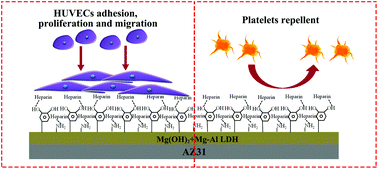当前位置:
X-MOL 学术
›
Biomater. Sci.
›
论文详情
Our official English website, www.x-mol.net, welcomes your
feedback! (Note: you will need to create a separate account there.)
Layered double hydroxide/poly-dopamine composite coating with surface heparinization on Mg alloys: improved anticorrosion, endothelialization and hemocompatibility†
Biomaterials Science ( IF 5.8 ) Pub Date : 2018-04-27 00:00:00 , DOI: 10.1039/c8bm00298c Hua Li 1, 2, 3, 4, 5 , Feng Peng 5, 6, 7, 8, 9 , Donghui Wang 5, 6, 7, 8, 9 , Yuqin Qiao 5, 6, 7, 8, 9 , Demin Xu 1, 2, 3, 4, 5 , Xuanyong Liu 5, 6, 7, 8, 9
Biomaterials Science ( IF 5.8 ) Pub Date : 2018-04-27 00:00:00 , DOI: 10.1039/c8bm00298c Hua Li 1, 2, 3, 4, 5 , Feng Peng 5, 6, 7, 8, 9 , Donghui Wang 5, 6, 7, 8, 9 , Yuqin Qiao 5, 6, 7, 8, 9 , Demin Xu 1, 2, 3, 4, 5 , Xuanyong Liu 5, 6, 7, 8, 9
Affiliation

|
Magnesium (Mg) and its alloys are promising cardiovascular stent materials due to their favourable physical properties and complete degradation in vivo. However, rapid degradation and poor cytocompatibility hinder their clinical applications. To enhance the corrosion resistance and endothelialization of the AZ31 alloy, a layered double hydroxide (LDH)/poly-dopamine (PDA) composite coating (LDH/PDA) was successfully fabricated. Polarization curves and the electrochemical impedance spectroscopy Nyquist spectrum test proved that the corrosion resistance of the LDH/PDA sample was significantly improved in vitro. The LDH/PDA sample greatly improved the adherence process and the proliferation rate of human umbilical vein endothelial cells (HUVECs). After culturing for 10 days, the number of living HUVECs on the LDH/PDA sample was comparable to that on the Ti sample whereas the cells barely survived on the AZ31 or LDH coating. Furthermore, heparin was immobilized on LDH/PDA via a covalent bond (LDH/PDA/HEP). The corrosion resistance and long-term proliferation of HUVECs after the introduction of heparin were mildly decreased compared with the L/P sample, but were still greatly improved compared with AZ31, the LDH coating and the PDA coating. Furthermore, the LDH/PDA/HEP sample greatly improved the HUVEC migration rate compared with the LDH/PDA sample, and inhibited platelet adhesion which was intense on the LDH/PDA sample. Both LDH/PDA and LDH/PDA/HEP samples had a low hemolysis rate (2.52% and 0.65%, respectively) in vitro and eliminated the adverse biocompatible effects of the direct PDA coating on the AZ31 substrate in vivo. Our results suggest that the LDH/PDA composite coating with further heparinization is a promising method to modify the surface of Mg alloys by significantly improving corrosion resistance, endothelialization and hemocompatibility.
中文翻译:

在镁合金上进行表面肝素化的双层氢氧化物/聚多巴胺复合涂层:改善的防腐性,内皮化性和血液相容性†
镁(Mg)及其合金由于其良好的物理特性和在体内的完全降解而成为很有前途的心血管支架材料。但是,快速降解和差的细胞相容性阻碍了它们的临床应用。为了增强AZ31合金的耐蚀性和内皮化性能,成功制备了层状双氢氧化物(LDH)/聚多巴胺(PDA)复合涂层(LDH / PDA)。极化曲线和电化学阻抗谱奈奎斯特光谱测试证明,LDH / PDA样品的抗腐蚀性在体外得到了显着改善。LDH / PDA样品极大地改善了人脐静脉内皮细胞(HUVEC)的粘附过程和增殖速率。培养10天后,LDH / PDA样品上的活HUVEC数量与Ti样品上的数量相当,而细胞在AZ31或LDH涂层上几乎没有存活。此外,肝素通过以下方式固定在LDH / PDA上共价键(LDH / PDA / HEP)。与L / P样品相比,加入肝素后HUVECs的耐腐蚀性和长期增殖有所降低,但与AZ31,LDH涂层和PDA涂层相比仍大大改善。此外,与LDH / PDA样品相比,LDH / PDA / HEP样品大大提高了HUVEC迁移速率,并抑制了在LDH / PDA样品上强烈的血小板粘附。LDH / PDA和LDH / PDA / HEP样品的体外溶血率均较低(分别为2.52%和0.65%),并且消除了直接PDA涂层在体内对AZ31底物的不利生物相容性影响。我们的结果表明,具有进一步肝素化作用的LDH / PDA复合涂层是一种通过显着提高耐蚀性,内皮化和血液相容性来修饰Mg合金表面的有前途的方法。
更新日期:2018-04-27
中文翻译:

在镁合金上进行表面肝素化的双层氢氧化物/聚多巴胺复合涂层:改善的防腐性,内皮化性和血液相容性†
镁(Mg)及其合金由于其良好的物理特性和在体内的完全降解而成为很有前途的心血管支架材料。但是,快速降解和差的细胞相容性阻碍了它们的临床应用。为了增强AZ31合金的耐蚀性和内皮化性能,成功制备了层状双氢氧化物(LDH)/聚多巴胺(PDA)复合涂层(LDH / PDA)。极化曲线和电化学阻抗谱奈奎斯特光谱测试证明,LDH / PDA样品的抗腐蚀性在体外得到了显着改善。LDH / PDA样品极大地改善了人脐静脉内皮细胞(HUVEC)的粘附过程和增殖速率。培养10天后,LDH / PDA样品上的活HUVEC数量与Ti样品上的数量相当,而细胞在AZ31或LDH涂层上几乎没有存活。此外,肝素通过以下方式固定在LDH / PDA上共价键(LDH / PDA / HEP)。与L / P样品相比,加入肝素后HUVECs的耐腐蚀性和长期增殖有所降低,但与AZ31,LDH涂层和PDA涂层相比仍大大改善。此外,与LDH / PDA样品相比,LDH / PDA / HEP样品大大提高了HUVEC迁移速率,并抑制了在LDH / PDA样品上强烈的血小板粘附。LDH / PDA和LDH / PDA / HEP样品的体外溶血率均较低(分别为2.52%和0.65%),并且消除了直接PDA涂层在体内对AZ31底物的不利生物相容性影响。我们的结果表明,具有进一步肝素化作用的LDH / PDA复合涂层是一种通过显着提高耐蚀性,内皮化和血液相容性来修饰Mg合金表面的有前途的方法。











































 京公网安备 11010802027423号
京公网安备 11010802027423号